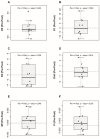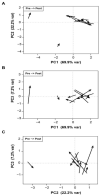Study of Quasispecies Complexity and Liver Damage Progression after Liver Transplantation in Hepatitis C Virus Infected Patients
- PMID: 34828337
- PMCID: PMC8625210
- DOI: 10.3390/genes12111731
Study of Quasispecies Complexity and Liver Damage Progression after Liver Transplantation in Hepatitis C Virus Infected Patients
Abstract
Cirrhosis derived from chronic hepatitis C virus (HCV) infection is still a common indication for liver transplantation (LT). Reinfection of the engrafted liver is universal in patients with detectable viral RNA at the time of transplant and causes fast progression of cirrhosis (within 5 years) in around one-third of these patients. To prevent damage to the liver graft, effective direct-acting antiviral (DAA) therapy is required as soon as possible. However, because of post-LT clinical instability, it is difficult to determine the optimal time to start DAAs with a low risk of complications. Evaluate changes in quasispecies complexity following LT and seek a predictive index of fast liver damage progression to determine the timing of DAA initiation. HCV genomes isolated from pre-LT and 15-day post-LT serum samples of ten patients, who underwent orthotopic LT, were quantified and sequenced using a next-generation sequencing platform. Sequence alignments, phylogenetic trees, quasispecies complexity measures, biostatistics analyses, adjusted R2 values, and analysis of variance (ANOVA) were carried out. Three different patterns of reinfection were observed (viral bottlenecking, conserved pre-LT population, and mixed populations), suggesting that bottlenecking or homogenization of the viral population is not a generalized effect after liver graft reinfection. None of the quasispecies complexity measures predicted the future degree of liver damage. Higher and more uniform viral load (VL) values were observed in all pre-LT samples, but values were more dispersed in post-LT samples. However, VL increased significantly from the pre-LT to 15-day post-LT samples in patients with advanced fibrosis at 1-year post-LT, suggesting that a VL increase on day 15 may be a predictor of fast liver fibrosis progression. HCV kinetics after LT differ between patients and are not fibrosis-dependent. Higher VL at day 15 post-LT versus pre-LT samples may predict fast liver fibrosis progression.
Keywords: complexity measures; fibrosis; hepatitis C virus; liver transplantation; variability; viral load.
Conflict of interest statement
Josep Gregori works in Roche Diagnostics. This fact did not change.
Figures






References
-
- Berenguer M., Prieto M., Rayón J.M., Mora J., Pastor M., Ortiz V., Carrasco D., San Juan F., Burgueño M.-J., Mir J., et al. Natural History of Clinically Compensated Hepatitis C Virus–Related Graft Cirrhosis After Liver Transplantation. Hepatology. 2000;32:852–858. doi: 10.1053/jhep.2000.17924. - DOI - PubMed
-
- Prieto M., Berenguer M., Rayón J.M., Córdoba J., Argúello L., Carrasco D., García-Herola A., Olaso V., De Juan M., Gobernado M., et al. High incidence of allograft cirrhosis in hepatitis C virus genotype 1b infection following transplantation: Relationship with rejection episodes. Hepatology. 1999;29:250–256. doi: 10.1002/hep.510290122. - DOI - PubMed
Publication types
MeSH terms
Substances
LinkOut - more resources
Full Text Sources
Medical

